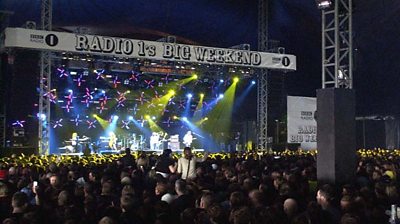What Can Go Wrong?
- Fire or gas leak
- Bomb threat.
- Structural failures e.g. collapse of the stage
- Severe weather
- Security issues outside the venue that may restrict access or egress
- Crowd-related incidents e.g. disorder or crushing.
Legal/����ý Requirements
- Attendance of Working Safely in Crowds Training course is recommended for those working in crowds where behaviour is likely to be ill humoured, antagonistic or involve an element of protest. It does not qualify staff to operate in a volatile crowds or where public disorder occurs.
Control Measures
General Controls
- Put into place plans for dealing with incidents and emergencies that can be managed effectively using the resources already onsite
- Create an emergency plan that is proportionate to the size of the event and the potential extent and severity of the incident.
- Clearly define a communication path and decision-making structure
The Plan
- Ensure the plan covers:
- Mobilising onsite resources to attend and tackle the incident
- Removing people from immediate danger
- The management of any casualties including providing medical assistance.
- Raising the alarm and informing the public and telling staff what they need to do
- Alerting and assisting emergency services
- Incident control
- Traffic management, including emergency vehicles
- Controlling crowds including evacuation
- Evacuation of disabled people
- Handing over to the emergency services where applicable
- Dealing with displaced and non-injured (e.g. at a festival with camping)
- Protecting property.
- Ensure that the plan is flexible to cope with changes in events.
- The plan for emergency situations should set out the overall framework for the initiation, management, co-ordination and control of personnel and assets to deal with an emergency onsite.
- Ensure that all relevant staff members, no matter what their normal working role, understand what they should do in the event of an emergency – including raising the alarm, the location of exits, emergency equipment, and from whom they should receive instructions etc
Emergency procedures
- Appoint people to be responsible for implementing the emergency procedures in the event of an incident or emergency situation.
- Ensure that a clear management structure is place, identifying the key decision makers.
- Plans are discussed with the police, fire and rescue service, the ambulance service, emergency planning and, for fixed premises such as stadiums and arenas, the venue management.
- Agreement with the emergency services on issues such as access routes to the site, the use of any grid-referenced maps, rendezvous points and transfer of authority for a major incident from the event organiser to the emergency services has been reached.
Division Specific Issues
- No division specific issues.
FAQs/Did You Know?
- A major incident plan (MIP) deals with threats to human welfare, where rescue is necessary. The MIP is shared with emergency services and can range from the treatment of casualties on site, to mass evacuation
- Some parts of the plan can be generic in nature and apply to all events e.g summoning assistance from the emergency services.
- For all but the smallest events with low risks (or those in fixed venues with established procedures), a major incident plan needs to be drawn up in consultation with the emergency services, and integrated with their plans and those of other authorities
- Employees and volunteers should be trained in emergency procedures, and be assigned to and understand their specific role should an incident occur.
- In almost every local authority there are now established safety advisory groups (SAGs) that are the point of joint contact. SAG provides a ready-made forum to communicate with the relevant authorities, and has the local knowledge that can help event organisers in delivery.
Useful documents
Recommended links
-
(����ý network only)
-
Events Safety Guide
-

Events Safety Guide
Visit the Events Safety Guide for a collection of topics related to organising your event.
More from SSR
-
Your platform to record accidents, risk assessments, assurance monitoring and inspections
-
Safety Equipment Stores
Just one number to call: 020 3614 5155 -
����ý Safety Guidelines
An A-Z of ����ý's Health and Safety Guidelines -
Safety Advice Line: 0370 411 0464 Email: safety@bbc.co.uk
Events guidance - key links:
- Exhibitions
- General Guidance
- Indoor Location Recce Checklist
- Outdoor Location Recce Checklist
- Major Incidents & Emergency Planning
- Marketing and Promotional
- Noise Exposure
- Planning and Management
- Responsibilities
- Responsibilities Form
- Laser Lighting Effects
- Strobe Lighting
- Temporary Stages and Rostra
Health topics - key links:
- (����ý network only)
- Contributors Fitness to Participate
- Display Screen Equipment (DSE)
- (����ý network only)
- First Aid and Welfare on Location
- International Travel - Risks & Health
- Manual Handling
- Mental Health: Homepage
- (����ý network only)
- Personal Health and Wellbeing
- Pregnancy
- Psychological Trauma Support & Trauma Risk Management (TRiM)
- Tiredness and Fatigue
- Travel Health Contacts
����ý High Risk - key links:
- CBRN and Industrial Spills
- Covert Filming
- Crisis Management and Security Support
- Demonstrations, Protests and Crowds
- Disaster Coverage
- Door Stepping
- (����ý network only)
- (����ý network only)
- Public Order
- Safety Equipment Stores
����ý Journalism - key links:
����ý Productions - key links:
- Aerial Filming and Airfields
- Animals: Displaying and handling for performance
- Boats: Working on
- Children and Young People
- Driving
- Electrical Equipment and Systems
- First Aid and Welfare on Location
- Food Safety (Cooking and Catering)
- Remote Location Working
- Roads and Streets: Working by
- Security of Productions on Location
- Stunts
- Tiredness and Fatigue
- Unmanned Aerial Systems (UAS aka Drones)
- Vehicles: Recording in, from and around
- Working at Height: Mobile Elevating Work Platforms
- Working at Height: Tower Scaffolds
����ý Radio - key links:
- (����ý Network only)
����ý Security - key links:
����ý Sport - key links:
About this site
This site describes what the ����ý does in relation to managing its health, safety and security risks and is intended for those who work directly for the ����ý.
It is not intended to provide instruction or guidance on how third parties should manage their risks. The ����ý cannot be held liable for how this information is interpreted or used by third parties, nor provide any assurance that adopting it would provide any measure of legal compliance. More information
Some links on this site are only accessible when connected to the ����ý network
